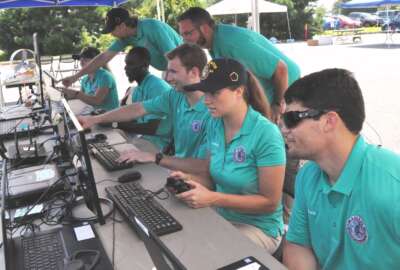
VA, DLA give high marks to robotics processing automation
For all the buzz around emerging technology in government, agency IT executives see an uncertain road ahead in looking for the next great innovation amid constr...
For all the buzz around emerging technology in government, agency IT executives see an uncertain road ahead in looking for the next great innovation amid constrained budgets.
Joseph Ronzio, the deputy chief technology officer at the Veterans Health Administration, said Thursday at an Association for Federal Information Resources Management (AFFIRM) luncheon on emerging technology, that as a health care provider, the VHA doesn’t have the budget to pursue every new tool.
“As taxpayers, you really don’t want me to have to buy a new medical imaging system for every point of care every 12 months … that would be ludicrously expensive as a taxpayer. So we’ve got to figure out how do we inject technology and how do we then step down things,” Ronzio said. “And that makes sense, because not everyone is going to come in and need everything plus the kitchen sink thrown at them.”
Leslie Perkins, the deputy chief technology officer for the Air Force’s Information Dominance and CIO (SAF/CIO A6) office, said requests for IT upgrades must compete with more exciting priorities, like more fighter jets.
“People just want the network that works,” Perkins said. “For the Air Force, I have another thing — I have to be secure. If something goes wrong, and I pop information, someone can die. I take that extremely seriously.”
Jeffrey Charlesworth, the director of strategic technologies and investments at the Defense Logistics Agency’s information operations, said the agency’s employees must also keep up with an accelerating rate of change in technology.
“If we’re all transforming at the speed of light, the workforce has to also, especially the IT workforce,” Charlesworth said.
RPA ‘working very well’ in weeding out menial tasks
The panel robotics process automation, running scripts to reduce the burden of menial tasks on employees, has emerged as a popular tool for several agencies.
“We’re adopting it now,” Charlesworth said. “It’s an amazing technology, it’s not that new. … It’s just scripting made user-friendly. We’ve been doing it for decades, but now it’s in a nice, neat package.”
At DLA, the agency has found success with using RPA in areas like finance reporting.
“Somebody’s got to do a report every month — well, let the bot do it,” Charlesworth said. “They do it 24 hours a day. They don’t ask for a raise, and they don’t take sick leave.”
Ronzio said RPA could not only reduce the burden of the workforce, but also maintain accuracy in those tasks.
“This is basic process improvement: Do you really still need to do those tasks? If we’re saying it’s just a script, I hate to say it, but on average, most scripting is done to overcome stupidity, and if we built the system correctly, we probably could ‘X’ out a lot of dumb processes,” he said.
Ronzio added that while researchers have “a bunch of puzzle pieces” that could lead to breakthroughs in artificial intelligence, it’s an area of study that still has some limitations.
“If I have an AI and it can’t talk to humans, what good is it? If I have an AI, but it can’t understand what’s out there in the physical, visual world, what good is it?” he said.
In the medical field, AI especially must make some advancements before being deployed.
“One of the reasons why medical residents go through hell for a couple of years is because they’re trying to cram every ‘if, then, else’ loop into their brain,” Ronzio said. “When something interesting comes up, they need to get exposed to it, so they can see it, just like you’re training a deep learning neural network.”
At present, however, he said no medical record system today is sophisticated enough to feed all that medical know-how into an AI program.
Tepid on blockchain
Ronzio also expressed some reservations on the distributed ledger technology blockchain, citing data security concerns.
“I have not seen one person sell a health-care blockchain technology that had any relevance that was actually blockchain,” he said. “Do not come to my office and tell me blockchain when you’re storing data someplace else, because guess what? I can corrupt that data. If you’re touting a fundamental distributed ledger system that is going to be indisputable, I need the data to be indisputable.”
Charlesworth added that there aren’t nearly enough government participants in blockchain to make it a worthwhile venture.
“Everybody’s got to be playing in it, or it doesn’t work,” Charlesworth said. “Until everybody starts adopting it, it’s like one chain in a link. I can create my own link, but I need a lot of other people to be in the same business at the same time.”
Copyright © 2024 Federal News Network. All rights reserved. This website is not intended for users located within the European Economic Area.
Jory Heckman is a reporter at Federal News Network covering U.S. Postal Service, IRS, big data and technology issues.
Follow @jheckmanWFED





